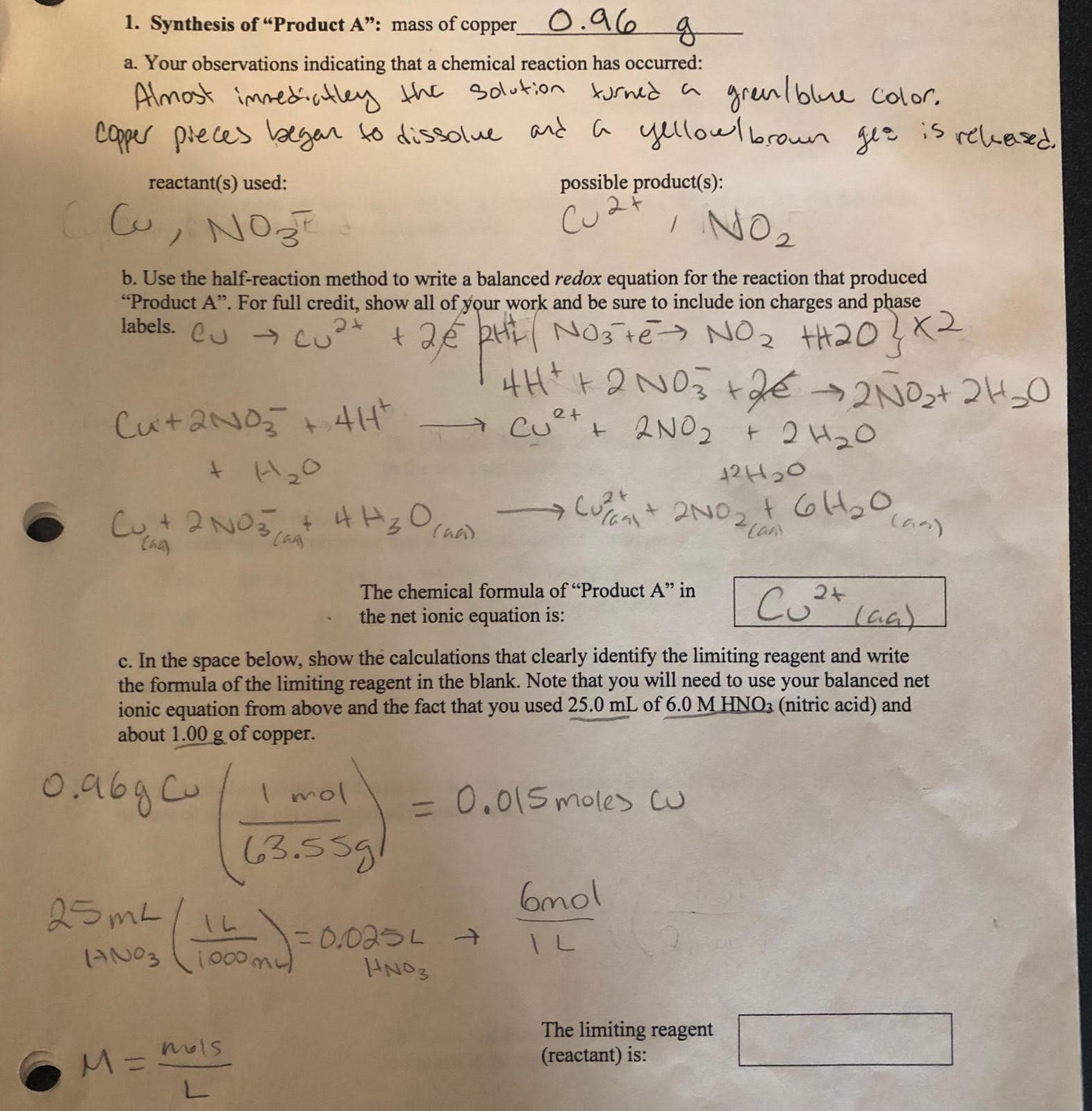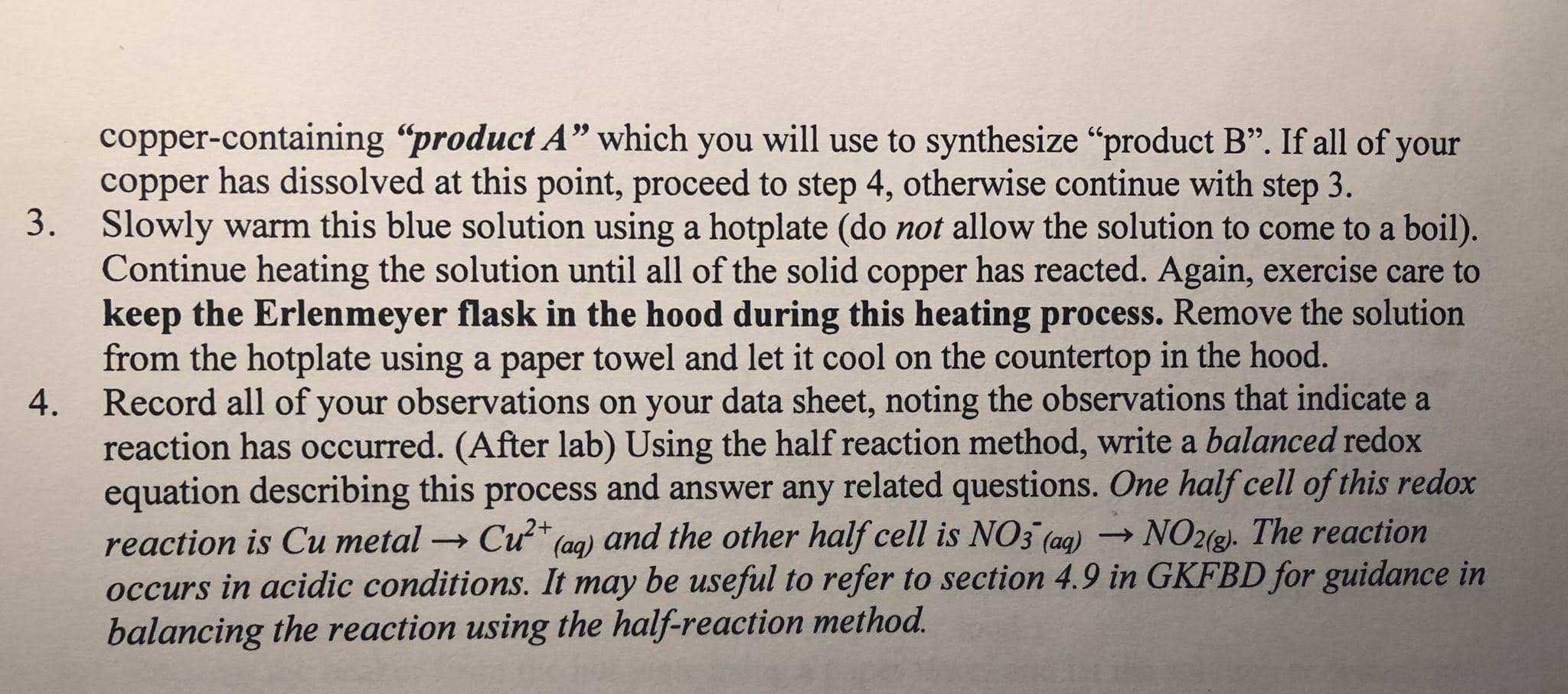O.alo 1. Synthesis of "Product A": mass of copper a. Your observations indicating that a chemical reaction has occurred: Almost imnesalle he oluton urn a Copper pleces lagan ko dissolue n lowlloroun grenlblue color. possible product(s): reactant(s) used: CCuNOR b. Use the half-reaction method to write a balanced redox equation for the reaction that produced "Product A". For full credit, show all of your work and be sure to include ion charges and phase labels. Cu NO3te NO2 th20K2 4H2NO3 e2Not 2O Cutanog4H +2NO2 + 220 12H20 Lam Caa The chemical formula of "Product A" in laa) the net ionic equation is: c. In the space below, show the calculations that clearly identify the limiting reagent and write the formula of the limiting reagent in the blank. Note that you will need to use your balanced net ionic equation from above and the fact that you used 25.0 mL of 6.0 M HNO3 (nitric acid) and about 1.00 g of copper. Imol - 0.015 moles cu 3.55g 6mol 0.035L L 1000mu 1ANO3 The limiting reagent (reactant) is: mls L copper-containing "product A" which you will use to synthesize "product B". If all of your has dissolved at this point, proceed to step 4, otherwise continue with step 3. Slowly warm this blue solution using a hotplate (do not allow the solution to come to a boil). Continue heating the solution until all of the solid copper has reacted. Again, exercise care to keep the Erlenmeyer flask in the hood during this heating process. Remove the solution сopper 3 from the hotplate using a paper towel and let it cool on the countertop in the hood. Record all of your observations on your data sheet, noting the observations that indicate a reaction has occurred. (After lab) Using the half reaction method, write a balanced redox questions. One half cell of this redox NO2(8). The reaction 4. related and answer any equation describing this process Cu (ag) and the other half cell is NO3 (ag) reaction is Cu metal occurs in acidic conditions. It may be useful to refer to section 4.9 in GKFBD for guidance in balancing the reaction using the half-reaction method.
O.alo 1. Synthesis of "Product A": mass of copper a. Your observations indicating that a chemical reaction has occurred: Almost imnesalle he oluton urn a Copper pleces lagan ko dissolue n lowlloroun grenlblue color. possible product(s): reactant(s) used: CCuNOR b. Use the half-reaction method to write a balanced redox equation for the reaction that produced "Product A". For full credit, show all of your work and be sure to include ion charges and phase labels. Cu NO3te NO2 th20K2 4H2NO3 e2Not 2O Cutanog4H +2NO2 + 220 12H20 Lam Caa The chemical formula of "Product A" in laa) the net ionic equation is: c. In the space below, show the calculations that clearly identify the limiting reagent and write the formula of the limiting reagent in the blank. Note that you will need to use your balanced net ionic equation from above and the fact that you used 25.0 mL of 6.0 M HNO3 (nitric acid) and about 1.00 g of copper. Imol - 0.015 moles cu 3.55g 6mol 0.035L L 1000mu 1ANO3 The limiting reagent (reactant) is: mls L copper-containing "product A" which you will use to synthesize "product B". If all of your has dissolved at this point, proceed to step 4, otherwise continue with step 3. Slowly warm this blue solution using a hotplate (do not allow the solution to come to a boil). Continue heating the solution until all of the solid copper has reacted. Again, exercise care to keep the Erlenmeyer flask in the hood during this heating process. Remove the solution сopper 3 from the hotplate using a paper towel and let it cool on the countertop in the hood. Record all of your observations on your data sheet, noting the observations that indicate a reaction has occurred. (After lab) Using the half reaction method, write a balanced redox questions. One half cell of this redox NO2(8). The reaction 4. related and answer any equation describing this process Cu (ag) and the other half cell is NO3 (ag) reaction is Cu metal occurs in acidic conditions. It may be useful to refer to section 4.9 in GKFBD for guidance in balancing the reaction using the half-reaction method.
Chapter18: Electrochemistry
Section: Chapter Questions
Problem 8RQ
Related questions
Question
I am working on this chemistry problem, and I am stuck on part C in order to get the limiting reagent.
Thanks much.

Transcribed Image Text:O.alo
1. Synthesis of "Product A": mass of copper
a. Your observations indicating that a chemical reaction has occurred:
Almost imnesalle he oluton urn a
Copper pleces lagan ko dissolue n lowlloroun
grenlblue color.
possible product(s):
reactant(s) used:
CCuNOR
b. Use the half-reaction method to write a balanced redox equation for the reaction that produced
"Product A". For full credit, show all of your work and be sure to include ion charges and phase
labels. Cu
NO3te NO2 th20K2
4H2NO3 e2Not 2O
Cutanog4H
+2NO2
+ 220
12H20
Lam
Caa
The chemical formula of "Product A" in
laa)
the net ionic equation is:
c. In the space below, show the calculations that clearly identify the limiting reagent and write
the formula of the limiting reagent in the blank. Note that you will need to use your balanced net
ionic equation from above and the fact that you used 25.0 mL of 6.0 M HNO3 (nitric acid) and
about 1.00 g of copper.
Imol
- 0.015 moles cu
3.55g
6mol
0.035L
L
1000mu
1ANO3
The limiting reagent
(reactant) is:
mls
L

Transcribed Image Text:copper-containing "product A" which you will use to synthesize "product B". If all of your
has dissolved at this point, proceed to step 4, otherwise continue with step 3.
Slowly warm this blue solution using a hotplate (do not allow the solution to come to a boil).
Continue heating the solution until all of the solid copper has reacted. Again, exercise care to
keep the Erlenmeyer flask in the hood during this heating process. Remove the solution
сopper
3
from the hotplate using a paper towel and let it cool on the countertop in the hood.
Record all of your observations on your data sheet, noting the observations that indicate a
reaction has occurred. (After lab) Using the half reaction method, write a balanced redox
questions. One half cell of this redox
NO2(8). The reaction
4.
related
and answer any
equation describing this
process
Cu (ag) and the other half cell is NO3 (ag)
reaction is Cu metal
occurs in acidic conditions. It may be useful to refer to section 4.9 in GKFBD for guidance in
balancing the reaction using the half-reaction method.
Expert Solution
This question has been solved!
Explore an expertly crafted, step-by-step solution for a thorough understanding of key concepts.
This is a popular solution!
Trending now
This is a popular solution!
Step by step
Solved in 2 steps with 1 images

Knowledge Booster
Learn more about
Need a deep-dive on the concept behind this application? Look no further. Learn more about this topic, chemistry and related others by exploring similar questions and additional content below.Recommended textbooks for you


Chemistry: An Atoms First Approach
Chemistry
ISBN:
9781305079243
Author:
Steven S. Zumdahl, Susan A. Zumdahl
Publisher:
Cengage Learning

Chemistry
Chemistry
ISBN:
9781305957404
Author:
Steven S. Zumdahl, Susan A. Zumdahl, Donald J. DeCoste
Publisher:
Cengage Learning


Chemistry: An Atoms First Approach
Chemistry
ISBN:
9781305079243
Author:
Steven S. Zumdahl, Susan A. Zumdahl
Publisher:
Cengage Learning

Chemistry
Chemistry
ISBN:
9781305957404
Author:
Steven S. Zumdahl, Susan A. Zumdahl, Donald J. DeCoste
Publisher:
Cengage Learning


Chemistry: Principles and Reactions
Chemistry
ISBN:
9781305079373
Author:
William L. Masterton, Cecile N. Hurley
Publisher:
Cengage Learning

Chemical Principles in the Laboratory
Chemistry
ISBN:
9781305264434
Author:
Emil Slowinski, Wayne C. Wolsey, Robert Rossi
Publisher:
Brooks Cole